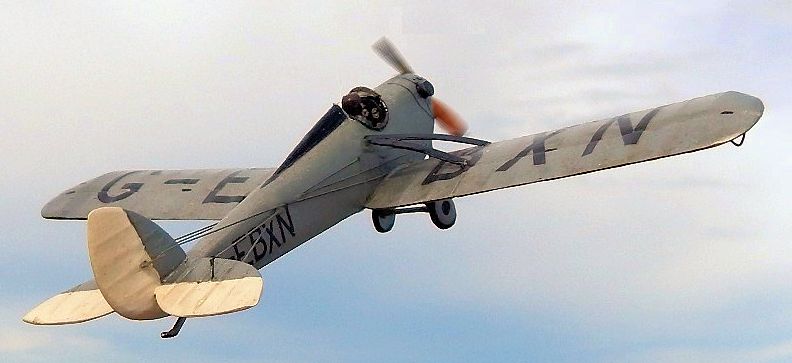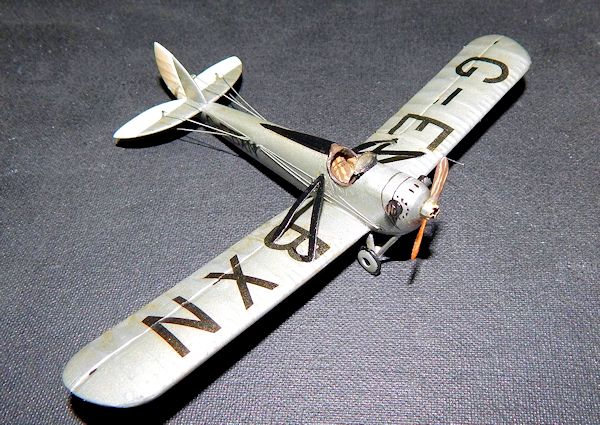
Airfix 1/72 DH.53 Hummingbird
| KIT #: | |
| PRICE: | |
| DECALS: | |
| REVIEWER: | Carmel J. Attard |
| NOTES: | Kitbashed using Airfix Tiger Moth kit |

| HISTORY |
Built by De Havilland of a
conventional construction plywood covered spruce fuselage, and two spar fabric
covered wings. It was fitted with a Douglas original engine that was later
replaced by a 26 hp Tomtit two-cylinder engine, which gave much improved
performance. An extra fuel tank was also fitted
 to the
original design. This formed a streamlined headrest being the pilot and rename “L’Oiseau
Mouche” and finished in silver and blue, carrying registration G-EBHX.
to the
original design. This formed a streamlined headrest being the pilot and rename “L’Oiseau
Mouche” and finished in silver and blue, carrying registration G-EBHX.
This aircraft left Stag Lane for
Belgium on 8th December 1923, flown
by Alan Cobham. The journey included stopping at Croydon Lympne and was flown
150 miles to the Brussels Aero Show in 4 hours. During 1924-25 seasons the
machine was raced by Cobham with some success. The second prototype “Sylvia II”
had made its first flight on October 1st
1923 and received a Certificate of Airworthiness the same day and was registered
G-EBHZ.
In
1955
the prototype G-EBHX was rediscovered in a back garden by Squadron Leader
Jackson of the Shuttleworth Trust. The starboard aileron, tail unit, engine
mounting, controls and fuel tanks missing! Eventually these missing items were
redesigned and built by De Havilland technical School, enabling the machine to
be restored. HX flew for the first time in over 25 years on August 1st
1960 at Hatfield. After trials, the aircraft was handed over to Shuttleworth
Trust to maintain in flying condition at Old Warden as the last survivor of the
type. On four occasions I visited Old Warden and on two of these I was able to
witness the Humming Bird flying
during a display there.
 The Dh-53
was also in service with the RAF when back in 1923 it was looking for an
economical aircraft for cheap communications and practical flying and the DH-53
proved the ideal type. The Air Ministry placed an order for eight of the
machines, which they named Humming Bird. These were delivered in summer of 1924
with serial numbers 107-114.
The Dh-53
was also in service with the RAF when back in 1923 it was looking for an
economical aircraft for cheap communications and practical flying and the DH-53
proved the ideal type. The Air Ministry placed an order for eight of the
machines, which they named Humming Bird. These were delivered in summer of 1924
with serial numbers 107-114.
The RAF machines
were all powered by 26hp Burney and Blackburn Tomtit two- cylinder engine. The
last two aircraft were sent to Farnborough to be fitted with special trapeze
experiments with R-33 Airship. These early Humming birds were finished in
overall silver with RAF roundels carried on fuselage sides and wing undersides.
All RAF eight machines were struck off charge in 1927, all receiving British
registration.
Of the five other Humming Birds built three went to Australia, one to Czechoslovakia and one to Russia. The eventual fate of the Humming Birds remains unknown. One was rebuilt by students at the College of Aeronautical Engineering at Brooklands in 1936, another rebuilt as the Martin Monoplane the following year.
| THE KIT |
I have used the old Airfix Tigermoth to model the DH-53. This was a simple conversion yet it added another completely new delightful model that falls in ‘between wars’ category.
| CONSTRUCTION |
 The kit
fuselage halves were first joined together then shortened 1/8” from the tail
end. The top decking was filed down to conform to scale plans I had. The inter
cockpit decking was then removed and front fuselage at leading edge of front
cockpit was sawn off. The lower fuselage was then sloped to conform to scale
plans and filled up the stand gap. Sides of fuselage were flattened with a
smooth file. The forward top decking was shaped from a solid piece of plastic, a
new cockpit cut and engine cowling built up and shaped from laminated plastic
card.
The kit
fuselage halves were first joined together then shortened 1/8” from the tail
end. The top decking was filed down to conform to scale plans I had. The inter
cockpit decking was then removed and front fuselage at leading edge of front
cockpit was sawn off. The lower fuselage was then sloped to conform to scale
plans and filled up the stand gap. Sides of fuselage were flattened with a
smooth file. The forward top decking was shaped from a solid piece of plastic, a
new cockpit cut and engine cowling built up and shaped from laminated plastic
card.
The Airfix kit
lower wing, the ailerons, and locating holes for struts were filled and new
ailerons scribed. Wings added to the fuselage so that they are at right angles
at leading edge to fuselage side. Any further fairing with Plasto filler was
done at this stage, which was mainly to the main wing root.
 Tail unit
was made from 1/16” plastic card and the surface ripples shaped with a half
round file. Wing struts cut from thin plastic card and the undercarriage struts
made out of stretch sprue and short lengths of Contrail struts. A set of wheels
of the right size was picked from scrap box. These were glued in place, as also
were the elevators and rudder. Measured lengths of control cables were cut after
a piece of sprue was stretched to a very narrow section. These were then glued
at the proper places. Other details such as the wing tip skids shaped from a
thin steel wire were added. In the end rudder and elevator links added, a thin
pitot tube glued to port wing leading edge, tail skid, two engine cylinders and
propeller blades all came from scrap box.
Tail unit
was made from 1/16” plastic card and the surface ripples shaped with a half
round file. Wing struts cut from thin plastic card and the undercarriage struts
made out of stretch sprue and short lengths of Contrail struts. A set of wheels
of the right size was picked from scrap box. These were glued in place, as also
were the elevators and rudder. Measured lengths of control cables were cut after
a piece of sprue was stretched to a very narrow section. These were then glued
at the proper places. Other details such as the wing tip skids shaped from a
thin steel wire were added. In the end rudder and elevator links added, a thin
pitot tube glued to port wing leading edge, tail skid, two engine cylinders and
propeller blades all came from scrap box.
| COLORS & MARKINGS |
| CONCLUSIONS |
The Dh-53 happened to be among the
smallest aircraft models I have made.
It is quite a marvel to think that one of the original
aircraft that was built 90 years ago is now still flying at Old Warden,
Begelswade, UK.
Carmel J. Attard
November 2013
If you would like your product reviewed fairly and fairly quickly, please contact the editor or see other details in the Note to Contributors.